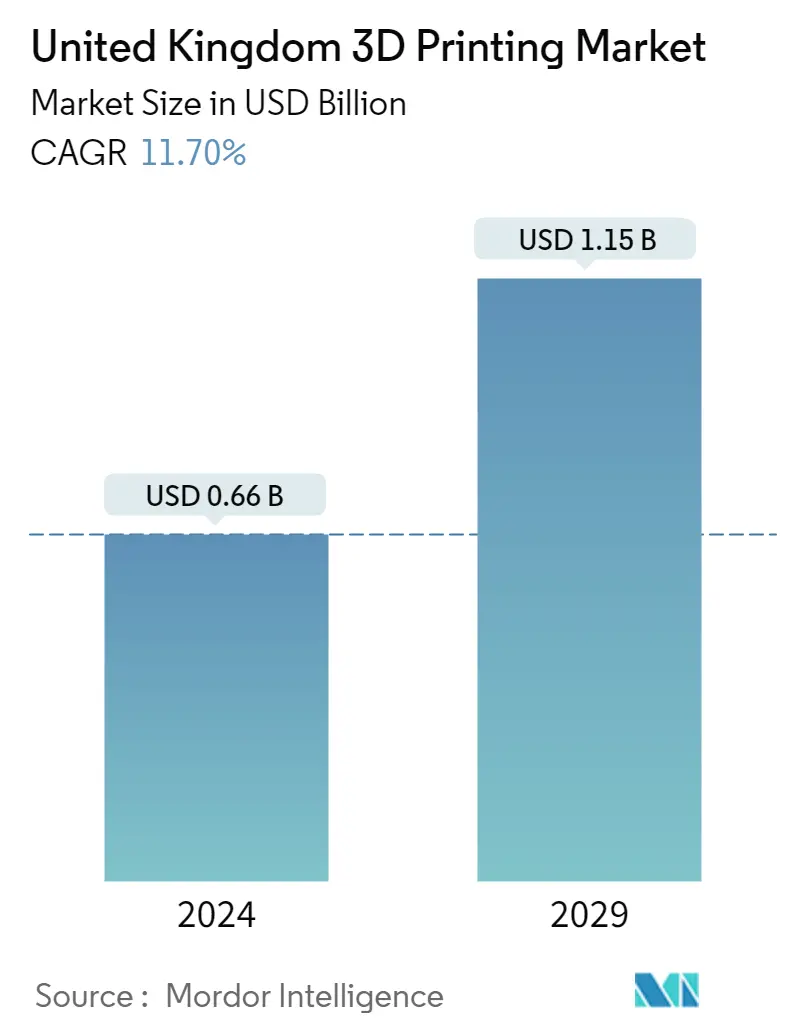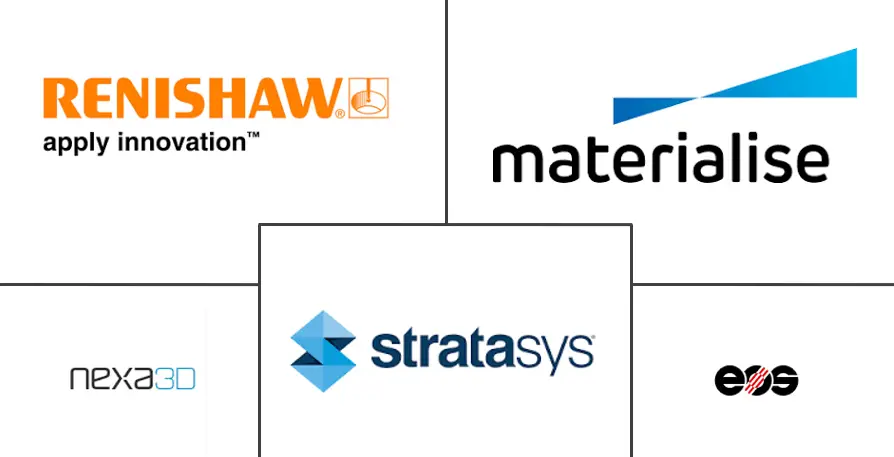Market Size of United Kingdom 3D Printing Industry

| Study Period | 2021 - 2029 |
| Base Year For Estimation | 2023 |
| Market Size (2024) | USD 0.66 Billion |
| Market Size (2029) | USD 1.15 Billion |
| CAGR (2024 - 2029) | 11.70 % |
| Market Concentration | Medium |
Major Players
*Disclaimer: Major Players sorted in no particular order |
Need a report that reflects how COVID-19 has impacted this market and its growth?
United Kingdom 3D Printing Market Analysis
The United Kingdom 3D Printing Market size is estimated at USD 0.66 billion in 2024, and is expected to reach USD 1.15 billion by 2029, growing at a CAGR of 11.70% during the forecast period (2024-2029).
The 3D printing market in the UK is growing because more industries are using additive manufacturing, more money is being spent on printers with higher capacities, technology is getting better, and government policies are getting better.
- The focus of 3D printing has shifted from design and prototyping to manufacturing valuable items. In contrast to traditional manufacturing techniques, 3D printing does not require tooling; thus, it can help overcome various obstacles, such as high tooling costs. Although conventional manufacturing has lower per-unit costs, the initial tooling expenses are high, making low-volume manufacturing more expensive. By building components layer by layer, 3D printing reduces the amount of waste generated during the manufacturing process. Another area where 3D printing is better than traditional manufacturing is mass customization, especially for short production runs.
- As 3D printing presents companies and consumers with a comprehensive and expanding range of technical and economic benefits, it has changed the paradigm for manufacturing processes from mass production in centralized factories constrained by tooling and low-cost labor rates to mass personalization with distributed manufacture. It has fueled its adoption in almost every sector. Recently, Rolls-Royce unveiled the most significant metal part made by 3D printing, which is a component for a Trent XWB-97 aircraft engine.
- Over the past five years, increased investment in research and development has encouraged innovation and boosted demand for 3D printing. The government has invested over USD 200 million into additive manufacturing to increase its market share from 5% to 8% in 2025 in the 3D printing market worldwide as it offers a lifeline to the British economy after Brexit.
- Moreover, the COVID-19 outbreak has infected more than 25 lakh people worldwide and caused more than 1.7 lakh fatalities. More than one lakh people are affected in the United Kingdom alone, resulting in a scarcity of critical protective equipment such as face masks.Many 3D-printer organizations are trying to resolve the problem by using an additive manufacturing method to produce facemasks. Some companies have already produced thousands of 3D-printed masks that are donated to hospitals, pharmacies, paramedics, and social-care homes. Further, the 3DCrowd UK group was set up by palliative-medicine doctor James Coxon to raise USD 40,000 through a GoFundMe crowdfunding campaign that will be used for the pandemic. Up until now, the group has successfully raised half the desired funds.
- However, small and medium-sized firms' common misconceptions about prototype procedures are impeding the adoption of additive manufacturing. Companies involved in the design, especially small and medium-sized businesses, are thinking about whether prototyping investments are good investments before trying to figure out what the pros and cons of the prototype are. The typical belief among these businesses is that prototyping is only an expensive step before manufacturing. Misconceptions about prototypes, a lack of technical knowledge, and a lack of traditional process controls are all things that are likely to slow the growth of the market.
United Kingdom 3D Printing Industry Segmentation
3D printing is a range of digital manufacturing technologies that produce component parts layer-by-layer through the additional use of materials. There are many different types of 3D printing processes, which are all controlled using three-dimensional digital data.
The 3D Printing Market in the United Kingdom is classified as follows: Printer (Industrial and Desktop), Material (Metal, Plastic, Ceramics, Others), and Application (Automotive, Aerospace and Defense, Healthcare, Construction and Architecture, and Other Applications).
The market sizes and forecasts are provided in terms of value (USD million) for all the above segments.
| Printer Type | |
| Industrial | |
| Desktop |
| Material Type | |
| Metal | |
| Plastic | |
| Ceramics | |
| Other Material Types |
| Application | |
| Automotive | |
| Aerospace and Defense | |
| Healthcare | |
| Construction and Architecture | |
| Other Applications |
United Kingdom 3D Printing Market Size Summary
The 3D printing market in the United Kingdom is experiencing significant growth due to increased adoption of additive manufacturing across various sectors, technological advancements, and supportive government policies. The market, which was initially focused on design and prototyping, has now shifted towards manufacturing valuable items. This shift is largely due to the ability of 3D printing to overcome challenges such as high tooling costs associated with traditional manufacturing techniques. Furthermore, 3D printing's ability to reduce waste and offer mass customization has made it a preferred choice for short production runs. The demand for 3D printing is increasing across various sectors including the automobile industry, healthcare, and robotics. Industrial-grade 3D printers are revolutionizing the manufacturing industry, offering benefits to both large and small manufacturers. In the healthcare sector, 3D printing is being used for a wide range of applications including tissue and organ fabrication, customized prosthetics, implants, and pharmaceutical research. The market is competitive with major players like Renishaw PLC, Stratasys Limited, EOS GmbH, Materialise NV, and AnisoPrint dominating the market. These companies are expanding their customer base through strategic collaborations and product innovations.
Explore MoreUnited Kingdom 3D Printing Market Size - Table of Contents
-
1. MARKET DYNAMICS
-
1.1 Market Overview
-
1.2 Market Drivers
-
1.2.1 Favorable Changes in Government Policies
-
1.2.2 Growing Demand for Industrial-grade 3D Printers
-
-
1.3 Market Restraints
-
1.3.1 High Price Competition and High Commodity Prices
-
-
1.4 Value Chain / Supply Chain Analysis
-
1.5 Porter's Five Forces Analysis
-
1.5.1 Threat of New Entrants
-
1.5.2 Bargaining Power of Buyers/Consumers
-
1.5.3 Bargaining Power of Suppliers
-
1.5.4 Threat of Substitute Products
-
1.5.5 Intensity of Competitive Rivalry
-
-
1.6 Assessment of COVID-19 Impact on the Industry
-
-
2. MARKET SEGMENTATION
-
2.1 Printer Type
-
2.1.1 Industrial
-
2.1.2 Desktop
-
-
2.2 Material Type
-
2.2.1 Metal
-
2.2.2 Plastic
-
2.2.3 Ceramics
-
2.2.4 Other Material Types
-
-
2.3 Application
-
2.3.1 Automotive
-
2.3.2 Aerospace and Defense
-
2.3.3 Healthcare
-
2.3.4 Construction and Architecture
-
2.3.5 Other Applications
-
-
United Kingdom 3D Printing Market Size FAQs
How big is the United Kingdom 3D Printing Market?
The United Kingdom 3D Printing Market size is expected to reach USD 0.66 billion in 2024 and grow at a CAGR of 11.70% to reach USD 1.15 billion by 2029.
What is the current United Kingdom 3D Printing Market size?
In 2024, the United Kingdom 3D Printing Market size is expected to reach USD 0.66 billion.
